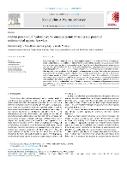Hidden potential of hydrazinecarboxamides (semicarbazides) as potential antimicrobial agents: A review

Publication date
2024Published in
Biomedicine & PharmacotherapyVolume / Issue
180 (November)ISBN / ISSN
ISSN: 0753-3322ISBN / ISSN
eISSN: 1950-6007Metadata
Show full item recordCollections
This publication has a published version with DOI 10.1016/j.biopha.2024.117556
Abstract
Hydrazinecarboxamides (semicarbazides) are increasingly recognized as a versatile scaffold in developing potential antimicrobial agents. In addition to a brief overview of the synthetic methods to prepare them, this review comprehensively analyses their antimicrobial properties. These derivatives have demonstrated potent activity against a broad spectrum of mycobacteria, bacterial and fungal pathogens, highlighting their potential to address critical human health challenges, including neglected diseases, and to combat growing antimicrobial resistance. They have also been investigated for their antiviral and antiparasitic properties. The review also summarizes structure-activity relationships, known mechanisms of action and emphasizes the crucial role of the hydrazinecarboxamide moiety in facilitating interactions with biological targets. The combination of hydrazinecarboxamides with other bioactive scaffolds (primaquine, isoniazid, etc.) has led to an identification of promising drug candidates, including those active against resistant strains, offering a promising approach for future innovations in the field of antimicrobial therapy. Attention is also drawn to limitations of hydrazinecarboxamides (poor physicochemical properties, cytotoxicity to human cells, and insufficient target selectivity), which may hinder their clinical application.
Keywords
Antibacterial activity, Antifungal activity, Antimycobacterial activity, Antiprotozoal activity, Hydrazinecarboxamides, Structure-activity relationship
Permanent link
https://hdl.handle.net/20.500.14178/2665License
Full text of this result is licensed under: Creative Commons Uveďte původ 4.0 International







